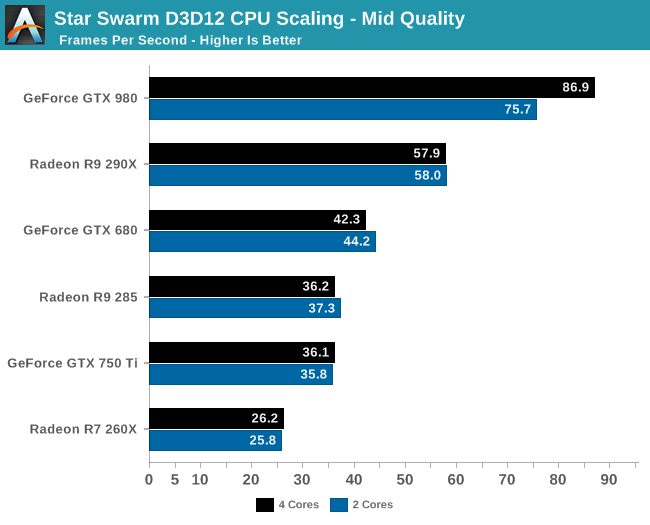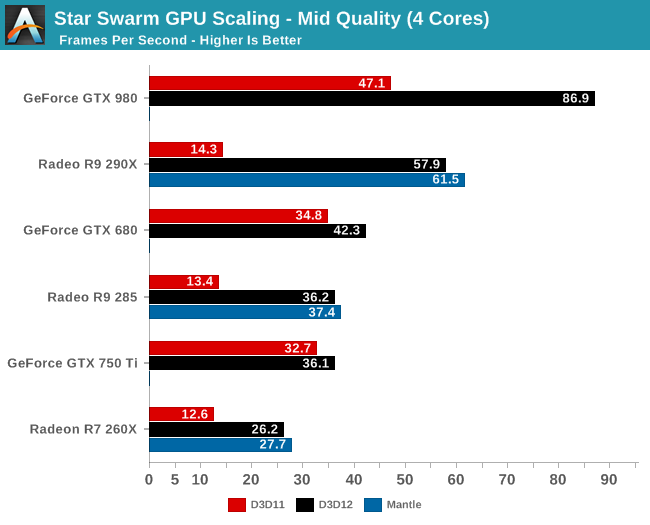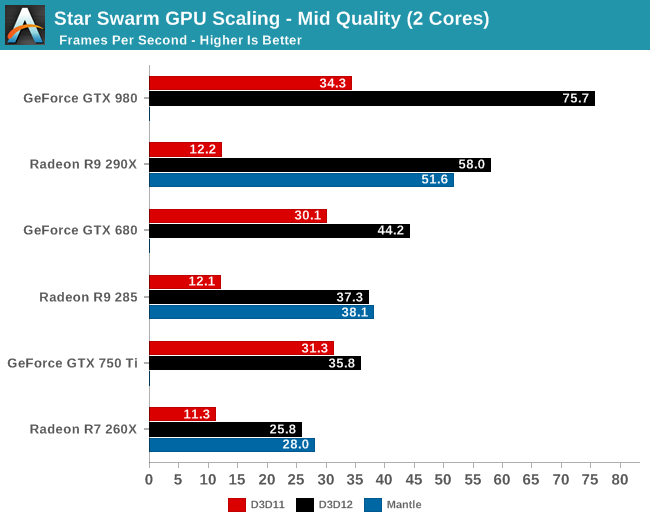The DirectX 12 Performance Preview: AMD, NVIDIA, & Star Swarm
by Ryan Smith on February 6, 2015 2:00 PM EST- Posted in
- GPUs
- AMD
- Microsoft
- NVIDIA
- DirectX 12
Mid Quality Performance
Since our evaluation so far has been focused on performance with Star Swarm’s most resource intensive Extreme setting, we wanted to shake things up by trying a lower quality setting.
In this case Star Swarm’s various quality levels adjust both the CPU and GPU workload, with the Mid quality setting reducing both the number of draw calls generated and the amount of work generated per frame for the GPU. As a result we’re not adjusting just the CPU or the GPU workload, but it can give us an idea of what to expect from DirectX 12 and Star Swarm at lower settings more suitable for weaker systems.

Even with this lower quality setting, the CPU results tell us that only the GTX 980 is truly CPU bottlenecked with 2 cores. Everything else from the 290X on down can reach its GPU limit with a relatively weak CPU.


Overall the numbers are different, but the lineup is the same whether it’s Extreme quality or Mid quality. Every vendor still sees massive gains from enabling DirectX 12, though the overall gains aren’t quite as great as with Extreme quality. Meanwhile GTX 750 Ti in particular continues to see the weakest gains from DirectX 12, at only 14% for a 2 core configuration, thanks to a combination of NVIDIA’s lower CPU consumption and earlier GPU bottleneck.










245 Comments
View All Comments
jeffkibuule - Saturday, February 7, 2015 - link
Right, it's a secret to the public, not so much to the engineers.Jumangi - Friday, February 6, 2015 - link
MS is a much bigger company so the resources they have give a big edge. I also suspect while AMD publicly still supports Mantle they probably aren't doing much for the future as they are smart enough, or I hope they are smart enough, to realize DX 12 makes Mantle irrelevant.toffty - Friday, February 6, 2015 - link
I wouldn't say Mantle is irrelevant since Directx12 is Windows 10 and Xbox One only. Mantle is for Window < 10, linux and OSX. It will be competing against OpenGL in that space, true, but if it's easier to port applications made with Mantle to Xbox One, Mantle will have a leg up on OpenGL. Mantle also needs to becomes open and nVidia supports it too.Penti - Saturday, February 7, 2015 - link
There is no mantle for anything else than Windows. PS4 uses it's own API's, Nintendo uses it's own API's, X1 doesn't straight up run the same runtime or API as DX on Windows and already have low-level features, D3D11.X is a superset of D3D/DX11. Games are normally DX/HLSL to begin with, so you don't need to mess around with shaders that much and converting formats. Converting GLSL to HLSL is practical though. Many engines also has their own shader languages and systems making stuff like Mantle's shading language similarities irrelevant. Most will design for something else as their first path than Mantle.Jumangi - Saturday, February 7, 2015 - link
Fanboys can get mad but Linux and OSX are irrelevant for mainstream gaming. So yes Mantle has no real future and will be forgotten about in a couple of years.bloodypulp - Sunday, February 8, 2015 - link
Keep on dreaming, Nvidia fangirl. Mantle is coming for SteamOS(Linux). Count on it.yannigr2 - Friday, February 6, 2015 - link
Mantle was the catalyst to bring DX12 closer. No reason for AMD to spend much resources on Mantle now. Job is done.Notmyusualid - Friday, February 6, 2015 - link
More or less my thinking too. Best to keep us all on the same page, so to speak.Respect to AMD, but let us all join the DX12 train together....
AnnonymousCoward - Saturday, February 7, 2015 - link
Not necessarily. How do you know it wasn't MS's idea even? Look at Khato's post above.tipoo - Friday, February 6, 2015 - link
What's the support status of Intels chips which are going to get it? I think all Iris models will, and a few of the higher end HD Graphics series parts will. Are they currently supported?It would be interesting to see if this could push the Iris Pro 5200 any further. Though this is more for the flip situation of a weak CPU with a strong GPU, rather than this strong CPU with a modest GPU.